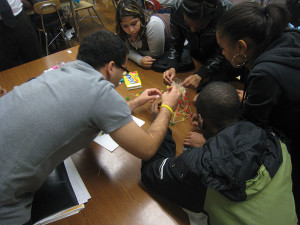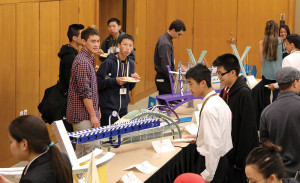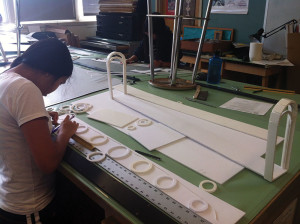Do you remember what inspired you to become a structural engineer? Did you love building blocks and toy construction sets when you were little? Maybe you had a relative who was an engineer or an architect. Maybe you loved problem solving, or you just wanted to build big things.
However you managed to get involved with this profession of ours, we remain a relatively small and unique selection of the general population. Our profession is typically not very well known or en vogue, but it has a strong impact on the lives of countless people. It is up to each of us to grow our profession by helping to mold the next generation of engineers and leaders within the industry. Without a strong corps of professionals volunteering to teach the next generation, it is possible that we may inadvertently stifle innovation, suppress fees, and by extension, wages, and reduce the talent pool due to attrition and lack of leadership.
Volunteering in schools is a great way to have a positive impact on students’ lives and improve the long-term well-being of our profession. Many engineers are already part of outreach programs that seek to introduce students to structural engineering in fun and meaningful ways. You too can make a difference in as little as a single classroom session by using the High School Outreach Program provided by the National Council of Structural Engineering Associations (NCSEA). Engineers Alliance for the Arts (EAA) and the Architecture Construction Engineering (ACE) Mentor Program feature the opportunity for students to learn about the engineering and design process over a longer in-depth program. All of these programs serve as catalysts for us to get involved in raising the next generation of engineers at varying levels of personal commitment.
High School Outreach Program
One way to get involved in helping to ensure the longevity of structural engineering, and to give back to the community, is to participate in a High School Outreach Program within your local NCSEA member organization (MO). This program is a simple, fun way for design professionals to engage with students and teachers and, in the process, demystify structural engineering and the architecture, engineering, construction (AEC) industry in general.
The High School Outreach program is defined by a 1 to 1½ hour workshop put on by design professionals in local schools during the school day. The workshop is generally composed of two parts. The first part is a short but comprehensive presentation on structural engineering and the AEC industry. The presentation may be customized to emphasize engineering challenges typical to the area, e.g. earthquakes in California, large snow drifts in Montana, or hurricanes in Florida. The second part is a hands-on activity used to strengthen the students’ understanding of some of the structural engineering principles detailed in the presentation. This is usually the fun part. Example activities include gum-drop and toothpick towers, and chocolate chip pudding concrete.
The High School Outreach Program is perfectly suited to be created and sustained by a volunteering committee within your MO. However, the program excels when a champion is found to actively recruit schools with willing teachers, and to organize the volunteers. Young Members Groups in several states have taken on the task of implementing this program with great success, and many MO’s have adapted the same basic program for both high school students and middle school students. The recent article in the August 2014 issue of STRUCTURE by Barnes and Dos Santos describes one adaptation for the middle school level.
The High School Outreach program represents a relatively short-term program that can reach multitudes of students and communities with the strength of its volunteer core. Start one of your own, or contact your local MO about getting involved. NCSEA has even created a guide available on the resources page of their website. The High School Outreach Start-Up Guide includes a sample presentation and a step-by-step rubric for building a base of schools interested in the program. This guide is available for download.

Boston area students race against the clock to build the tallest tower during a High School Outreach program workshop.
Engineers Alliance for the Arts
Another extraordinary way to engage younger members of the community is through the Engineers Alliance for the Arts (EAA) organization. EAA was founded in 2000 by several San Francisco Bay Area structural engineers to introduce engineering concepts specifically to visual and performing arts students. This organization seeks to bridge the gap between art-and-architecture and structural engineering, thereby aiding in the development of well–rounded, unique minds capable of understanding the world through both an engineering and artistic framework.
The flagship program within the organization is called the Student Impact Project, in which volunteer engineers teach in a classroom once per week for ten weeks. Volunteers are equipped with a curriculum that has been developed by the EAA curriculum committee and is approved by several school districts in California. The curriculum begins with general engineering concepts, but students quickly dive deeper into specific structural systems as they build and test prototype girder, arch, and suspension bridges. Along the way, students also learn about efficiency, scale, sustainability, and presentation skills. The program culminates with a final project – a physical scale model bridge and presentation that represents each student team’s entry into a realistic design competition based on a specific scenario. A final competition is held in which students must present their bridge to a group of design professions and sell their idea as the best. Projects are judged based on several factors including structural efficiency, aesthetics, and student presentation.
The program is held in such high regard that there is a long wait list for teachers at multiple schools around the San Francisco Bay Area. EAA has recently expanded to other U.S. cities due to overwhelming demand for programs like this from schools, teachers, students, and structural engineering professionals alike. As a 10-week program, volunteers make strong connections with the students, but without the commitment of a full school year. It does take a few hours out of your workday, but working with students in local schools and teaching them the fundamentals of engineering is a rewarding experience. Finally, by volunteering for this program you get to ensure the future of our profession while also meeting other design professionals from your area. Please do not hesitate to start or participate in an EAA program near you. Visit EAA’s website for an overview of the organization and contact EAA Executive Director Kelly Bitzer for opportunities to participate in your region.
ACE Mentor Program
The ACE Mentor Program was founded by Charles Thornton in 1994 in New York City, and it has grown into a national program that every year mentors over 8,000 high school students who are interested in Architecture, Construction and Engineering. ACE Teams consist of 20-25 students and industry mentors that represent the project owner (client), the design disciplines (architecture, civil, structural, mechanical, electrical, and plumbing), and construction managers. Over the course of a school year, ACE teams develop a design project that covers all disciplines, and most teams construct a model of their design project. At the end of the season, each team gives a presentation explaining their design to other teams, family members, teachers, prospective mentors, and ACE Board Members and company principals.
The ACE Mentor Program has active Affiliates in most states that each comprise multiple teams. Each team meets after school for 2 hours, either weekly or bi-weekly, from October through May. Many teams have company sponsors which provide funds for model materials and refreshments at team meetings. In addition to developing a project, teams take field trips to construction sites or construction trade apprenticeship facilities. Finally, many ACE Affiliates offer college scholarships for promising graduates of the program who go on to study architecture, construction, or engineering. If you are interested in volunteering, find a local ACE Affiliate at the ACE Mentor Program Website.
Find Your Fit and Fund Your Find
These options, which represent a range of opportunities and time commitments, have each been successfully used by many design professionals to inspire and develop some of the bright young engineers in firms throughout the country today. However, they are by no means exhaustive. If you have a particularly ambitious venture, note that NCSEA has recently launched a grant program whereby interested members can apply for funds to advance the profession through research, outreach, or other creative means. Any program that can help introduce developing minds to the profession certainly deserves consideration for such a grant, whether you wish to begin a brand new program or expand upon any of the opportunities mentioned in this article. The grant application can be found at the NCSEA website. Applications are due on February 15, 2015, and grants will be awarded on March 15, 2015.
The actions of engineers like you are what will lead our profession to new heights. By volunteering your time and expertise, you will become the leader that directs our profession and new leaders for decades to come. You have more power than you realize. Take action. Get involved. You will not regret it. It may even be more fun than running calculations.▪


